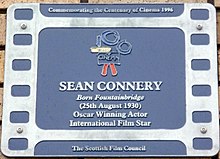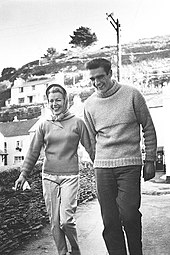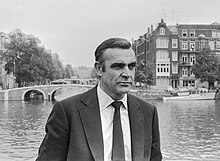Sir Sean Connery born Thomas Connery; 25 August 1930 – 31 October 2020 was a Scottish actor. He was the first actor to portray fictional British secret agent James Bond on film, starring in seven Bond films between 1962 and 1983. Originating the role in Dr. No, Connery played Bond in six of Eon Productions’ entries and made his final appearance in the Jack Schwartzman-produced Never Say Never Again.
Connery began acting in smaller theatre and television productions until his breakout role as Bond. Although he did not enjoy the off-screen attention the role gave him, the success of the Bond films brought Connery offers from notable directors such as Alfred Hitchcock, Sidney Lumet and John Huston. Their films in which Connery appeared included Marnie (1964), The Hill (1965), Murder on the Orient Express (1974), The Man Who Would Be King (1975), A Bridge Too Far (1977), Highlander (1986), The Name of the Rose (1986), The Untouchables (1987), Indiana Jones and the Last Crusade (1989), The Hunt for Red October (1990), Dragonheart (1996), The Rock (1996), and Finding Forrester (2000). Connery officially retired from acting in 2006, although he briefly returned for voice-over roles in 2012.
His achievements in film were recognised with an Academy Award, two BAFTA Awards (including the BAFTA Fellowship), and three Golden Globes, including the Cecil B. DeMille Award and a Henrietta Award. In 1987, he was made a Commander of the Order of Arts and Letters in France, and he received the US Kennedy Center Honors lifetime achievement award in 1999. Connery was knighted in the 2000 New Year Honours for services to film drama.
In 2004, a poll in the UK Sunday Herald recognized Connery as “The Greatest Living Scot” and a 2011 EuroMillions survey named him “Scotland’s Greatest Living National Treasure”. He was voted by People magazine as the “Sexiest Man Alive” in 1989 and the “Sexiest Man of the Century” in 1999.
Early life

Sean Connery plaque near the site of his birth in Fountainbridge, Edinburgh

Connery’s birth certificate
Thomas Connery, named Thomas after his paternal grandfather, was born at the Edinburgh Royal Maternity Hospital on 25 August 1930 and brought up at No. 176 Fountainbridge, a block which has since been demolished, in Edinburgh, Scotland. His mother, Euphemia “Effie” McBain McLean, was a cleaning woman. She was born the daughter of Neil McLean and Helen Forbes Ross, and named after her father’s mother, Euphemia McBain, wife of John McLean and daughter of William McBain from Ceres in Fife. Connery’s father, Joseph Connery, was a factory worker and lorry driver.
Two of his paternal great-grandparents emigrated to Scotland from Wexford, Ireland in the mid-19th century, with his great-grandfather, James Connery, being an Irish Traveller. The remainder of his family was of Scottish descent, and his maternal great-grandparents were native Scottish Gaelic speakers from Fife and Uig on Skye. His father was a Roman Catholic, and his mother was a Protestant. Connery had a younger brother, Neil. He was generally referred to in his youth as “Tommy.” Although he was small in primary school, he grew rapidly around the age of 12, reaching his full adult height of 6 ft 2 in (188 cm) at 18. He was known during his teen years as “Big Tam,” and said he lost his virginity to an adult woman in an ATS uniform at the age of 14.
Connery’s first job was as a milkman in Edinburgh with St. Cuthbert’s Co-operative Society. In 2009, Connery recalled a conversation in a taxi:
When I took a taxi during a recent Edinburgh Film Festival, the driver was amazed that I could put a name to every street we passed. “How come?” he asked. “As a boy I used to deliver milk round here”, I said. “So what do you do now?” That was rather harder to answer.
In 1946, at the age of 16, Connery joined the Royal Navy, during which time he acquired two tattoos, of which his official website says “unlike many tattoos, his were not frivolous — his tattoos reflect two of his lifelong commitments: his family and Scotland. … One tattoo is a tribute to his parents and reads ‘Mum and Dad’, and the other is self-explanatory, ‘Scotland Forever'”. He trained in Portsmouth at the naval gunnery school and in an anti-aircraft crew. He was later assigned as an Able Seaman on HMS Formidable. Connery was discharged from the navy at the age of 19 on medical grounds because of a duodenal ulcer, a condition that affected most of the males in previous generations of his family.
Afterwards, he returned to the co-op, then worked as, among other things, a lorry driver, a lifeguard at Portobello swimming baths, a labourer, an artist’s model for the Edinburgh College of Art, and after a suggestion by former Mr. Scotland, Archie Brennan, a coffin polisher. The modelling earned him 15 shillings an hour. Artist Richard Demarco, at the time a student who painted several early pictures of Connery, described him as “very straight, slightly shy, too, too beautiful for words, a virtual Adonis”.
Connery began bodybuilding at the age of 18, and from 1951 trained heavily with Ellington, a former gym instructor in the British Army. While his official website states he was third in the 1950 Mr. Universe contest, most sources place him in the 1953 competition, either third in the Junior class or failing to place in the Tall Man classification. Connery said he was soon deterred from bodybuilding when he found that Americans frequently beat him in competitions because of sheer muscle size and, unlike Connery, refused to participate in athletic activity which could make them lose muscle mass.
Connery was a keen footballer, having played for Bonnyrigg Rose in his younger days. He was offered a trial with East Fife. While on tour with South Pacific, Connery played in a football match against a local team that Matt Busby, manager of Manchester United, happened to be scouting. According to reports, Busby was impressed with his physical prowess and offered Connery a contract worth £25 a week (equivalent to £703 in 2019) immediately after the game. Connery said he was tempted to accept, but he recalls, “I realised that a top-class footballer could be over the hill by the age of 30, and I was already 23. I decided to become an actor and it turned out to be one of my more intelligent moves”.
Career
1950s
Seeking to supplement his income, Connery helped out backstage at the King’s Theatre in late 1951. During a bodybuilding competition held in London in 1953, one of the competitors mentioned that auditions were being held for a production of South Pacific, and Connery landed a small part as one of the Seabees chorus boys. By the time the production reached Edinburgh, he had been given the part of Marine Cpl. Hamilton Steeves and was understudying two of the juvenile leads, and his salary was raised from £12 to £14–10s a week. The production returned the following year, out of popular demand, and Connery was promoted to the featured role of Lieutenant Buzz Adams, which Larry Hagman had portrayed in the West End.
While in Edinburgh, Connery was targeted by the Valdor gang, one of the most violent in the city. He was first approached by them in a billiard hall where he prevented them from stealing his jacket and was later followed by six gang members to a 15-foot-high balcony at the Palais de Danse. There, Connery singlehandedly launched an attack against the gang members, grabbing one by the throat and another by a biceps and cracked their heads together. From then on, he was treated with great respect by the gang and gained a reputation as a “hard man”.
Connery first met Michael Caine at a party during the production of South Pacific in 1954, and the two later became close friends. During this production at the Opera House, Manchester over the Christmas period of 1954, Connery developed a serious interest in the theatre through American actor Robert Henderson who lent him copies of the Ibsen works Hedda Gabler, The Wild Duck, and When We Dead Awaken, and later listed works by the likes of Proust, Tolstoy, Turgenev, Bernard Shaw, Joyce, and Shakespeare for him to digest. Henderson urged him to take elocution lessons and got him parts at the Maida Vale Theatre in London. He had already begun a film career, having been an extra in Herbert Wilcox’s 1954 musical Lilacs in the Spring alongside Anna Neagle.
Although Connery had secured several roles as extras, he was struggling to make ends meet, and was forced to accept a part-time job as a babysitter for journalist Peter Noble and his actress wife Marianne, which earned him 10 shillings a night. He met Hollywood actress Shelley Winters one night at Noble’s house, who described Connery as “one of the tallest and most charming and masculine Scotsmen” she’d ever seen, and later spent many evenings with the Connery brothers drinking beer. Around this time, Connery was residing at TV presenter Llew Gardner’s house. Henderson landed Connery a role in a £6 a week Q Theatre production of Agatha Christie’s Witness for the Prosecution, during which he met and became friends with fellow-Scot Ian Bannen. This role was followed by Point of Departure and A Witch in Time at Kew, a role as Pentheus opposite Yvonne Mitchell in The Bacchae at the Oxford Playhouse, and a role opposite Jill Bennett in Eugene O’Neill’s play Anna Christie.
During his time at the Oxford Theatre, Connery won a brief part as a boxer in the TV series The Square Ring, before being spotted by Canadian director Alvin Rakoff, who gave him multiple roles in The Condemned, shot on location in Dover in Kent. In 1956, Connery appeared in the theatrical production of Epitaph, and played a minor role as a hoodlum in the “Ladies of the Manor” episode of the BBC Television police series Dixon of Dock Green. This was followed by small television parts in Sailor of Fortune and The Jack Benny Program (on a special episode filmed in Europe).

Connery with Lana Turner in 1957 on the set of Another Time, Another Place
In early 1957, Connery hired agent Richard Hatton who got him his first film role, as Spike, a minor gangster with a speech impediment in Montgomery Tully’s No Road Back alongside Skip Homeier, Paul Carpenter, Patricia Dainton, and Norman Wooland. In April 1957, Rakoff – after being disappointed by Jack Palance – decided to give the young actor his first chance in a leading role, and cast Connery as Mountain McLintock in BBC Television’s production of Requiem for a Heavyweight, which also starred Warren Mitchell and Jacqueline Hill. He then played a rogue lorry driver, Johnny Yates, in Cy Endfield’s Hell Drivers (1957) alongside Stanley Baker, Herbert Lom, Peggy Cummins, and Patrick McGoohan. Later in 1957, Connery appeared in Terence Young’s poorly received MGM action picture Action of the Tiger opposite Van Johnson, Martine Carol, Herbert Lom, and Gustavo Rojo; the film was shot on location in southern Spain. He also had a minor role in Gerald Thomas’s thriller Time Lock (1957) as a welder, appearing alongside Robert Beatty, Lee Patterson, Betty McDowall, and Vincent Winter; this commenced filming on 1 December 1956 at Beaconsfield Studios.
Connery had a major role in the melodrama Another Time, Another Place (1958) as a British reporter named Mark Trevor, caught in a love affair opposite Lana Turner and Barry Sullivan. During filming, Turner’s possessive gangster boyfriend, Johnny Stompanato, who was visiting from Los Angeles, believed she was having an affair with Connery. Connery and Turner had attended West End shows and London restaurants together. Stompanato stormed onto the film set and pointed a gun at Connery, only to have Connery disarm him and knock him flat on his back. Stompanato was banned from the set. Two Scotland Yard detectives advised Stompanato to leave and escorted him to the airport, where he boarded a plane back to the United States. Connery later recounted that he had to lay low for a while after receiving threats from men linked to Stompanato’s boss, Mickey Cohen.
In 1959, Connery landed a leading role in director Robert Stevenson’s Walt Disney Productions film Darby O’Gill and the Little People (1959) alongside Albert Sharpe, Janet Munro, and Jimmy O’Dea. The film is a tale about a wily Irishman and his battle of wits with leprechauns. Upon the film’s initial release, A. H. Weiler of The New York Times praised the cast (save Connery whom he described as “merely tall, dark, and handsome”) and thought the film an “overpoweringly charming concoction of standard Gaelic tall stories, fantasy and romance”. He also had prominent television roles in Rudolph Cartier’s 1961 productions of Adventure Story and Anna Karenina for BBC Television, the latter of which he co-starred with Claire Bloom. Also in 1961 he portrayed the title role in a CBC television film adaptation of Shakespeare’s Macbeth with Australian actress Zoe Caldwell cast as Lady Macbeth.
James Bond: 1962–1971, 1983

Connery as Bond (with co-star Tania Mallet) while filming Goldfinger in 1964
Connery’s breakthrough came in the role of British secret agent James Bond. He was reluctant to commit to a film series, but understood that if the films succeeded, his career would greatly benefit. Between 1962 and 1967, Connery played 007 in Dr. No, From Russia with Love, Goldfinger, Thunderball, and You Only Live Twice, the first five Bond films produced by Eon Productions. After departing from the role, Connery returned for the seventh film, Diamonds Are Forever, in 1971. Connery made his final appearance as Bond in Never Say Never Again, a 1983 remake of Thunderball produced by Jack Schwartzman’s Taliafilm. All seven films were commercially successful. James Bond, as portrayed by Connery, was selected as the third-greatest hero in cinema history by the American Film Institute.
Connery’s selection for the role of James Bond owed a lot to Dana Broccoli, wife of producer Albert “Cubby” Broccoli, who is reputed to have been instrumental in persuading her husband that Connery was the right man. James Bond’s creator, Ian Fleming, originally doubted Connery’s casting, saying, “He’s not what I envisioned of James Bond looks,” and “I’m looking for Commander Bond and not an overgrown stunt-man”, adding that Connery (muscular, 6′ 2″, and a Scot) was unrefined. Fleming’s girlfriend Blanche Blackwell told him Connery had the requisite sexual charisma, and Fleming changed his mind after the successful Dr. No première. He was so impressed, he wrote Connery’s heritage into the character. In his 1964 novel You Only Live Twice, Fleming wrote that Bond’s father was Scottish and from Glencoe in the Scottish Highlands.

Connery during filming for Diamonds Are Forever in 1971
Connery’s portrayal of Bond owes much to stylistic tutelage from director Terence Young, who helped polish him while using his physical grace and presence for the action. Lois Maxwell, who played Miss Moneypenny, related that “Terence took Sean under his wing. He took him to dinner, showed him how to walk, how to talk, even how to eat”. The tutoring was successful; Connery received thousands of fan letters a week after Dr. No’s opening, and he became a major sex symbol in film.
Following the release of the film Dr. No in 1962, the line “Bond … James Bond”, became a catch phrase in the lexicon of Western popular culture. Film critic Peter Bradshaw writes, “It is the most famous self-introduction from any character in movie history. Three cool monosyllables, surname first, a little curtly, as befits a former naval commander. And then, as if in afterthought, the first name, followed by the surname again. Connery carried it off with icily disdainful style, in full evening dress with a cigarette hanging from his lips. The introduction was a kind of challenge, or seduction, invariably addressed to an enemy. In the early 60s, Connery’s James Bond was about as dangerous and sexy as it got on screen”.
During the filming of Thunderball in 1965, Connery’s life was in danger in the sequence with the sharks in Emilio Largo’s pool. He had been concerned about this threat when he read the script. Connery insisted that Ken Adam build a special Plexiglas partition inside the pool, but this was not a fixed structure, and one of the sharks managed to pass through it. He had to abandon the pool immediately.
Beyond Bond

Connery in Alfred Hitchcock’s Marnie (1964)
